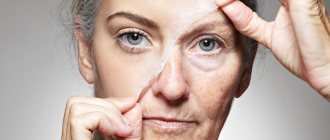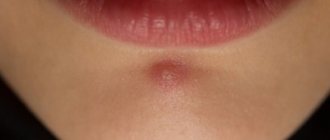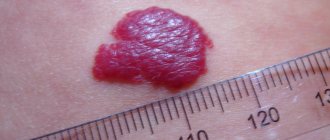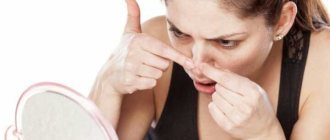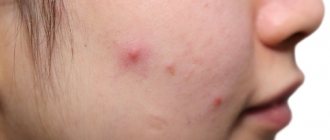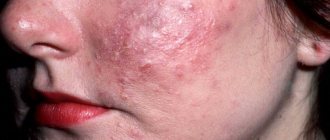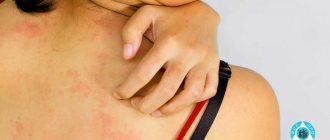The human body is an incredible system. If a failure is detected, “protective” mechanisms are triggered.” It is the appearance of allergic acne on the skin that is a sign that a malfunction has occurred in the body. Before starting treatment, you need to find out the mechanisms of their occurrence.
Photo 1 - Allergic acne
Allergy or not?
Photo 2 - Allergy or not?
Allergies occur due to increased susceptibility to various substances - allergens. The role of such substances can be various elements of food (various foods, drinks), household items (synthetic fabrics with dyes, cosmetics, detergents and cleaning products), and the external environment (dust, pollen).
Photo 3 - Spread of allergies
If it becomes clear that acne on the body is a manifestation of an allergy, a specialist will certainly determine the cause that caused it using additional research methods (blood tests, allergy tests) and prescribe appropriate treatment or make adjustments to the usual diet.
Photo 4 - A blood test will show what you are allergic to
How to get rid of it?
Photo 5 - Allergic acne on the body
Having discovered acne on the face, many people begin to self-medicate without consulting a doctor, because they believe that inflamed areas on the skin do not deserve to see a specialist, but this is not correct.
Photo 6 - The problem of allergic acne
Photo 7 - Allergic reaction in the form of acne
Pimples signal various problems in the body, and therefore, before prescribing treatment, you need to determine what the inflamed areas of the skin look like, because they may indicate an allergy. Such acne appears on the body in the form of various rashes that are accompanied by itching.
Photo 8 - Acne on the body due to allergies
Most often they appear on the face.
Photo 9 - The problem of allergic acne on the face
Photo 10 - Allergic acne on the face
Attention! Treatment of allergic acne on the face, which often involves a lot of difficulties, requires mandatory contact with an appropriate specialist, since only he can determine the immediate cause and prescribe adequate treatment.
Depending on the cause, the patient is prescribed medications for internal or external use. Also, in consultation with the doctor, the patient can use folk remedies, the treatment of which involves the use of herbal compresses, decoctions, ingestion of herbal infusions, as well as the application of potato starch, kefir, etc. as a mask. No less often, such a problem as an allergic reaction is not only on the body, pimples on the hands are also the first sign of an allergy. Such localization may indicate the presence of dermatitis.
Photo 11 - Allergic acne on the hands
It should be noted that if allergic acne is found in a child, then its treatment is possible only after consultation with a specialist, since the use of folk recipes, and especially the use of medications without a doctor’s prescription, can only aggravate the process.
Photo 12 - Allergic acne in a child
What can act as an allergen?
People of any age are susceptible to allergies, including infants. Allergy in the form of acne on the face in babies occurs due to the intake of an irritating factor with mother's milk, with complementary foods and as a result of external influences (creams, ointments, etc.). In older children and adults, the immune system is more stable, but the reaction is still common. Irritants provoke excessive production of histamine, a substance that regulates metabolic processes. The metabolism goes astray, and the body reacts with rashes.
Allergens may be:
- irritant products to which a person has an individual intolerance (citrus fruits, milk, peanuts, chocolate, honey, etc.);
- cosmetics and medications containing irritants;
- plant pollen, mold, dust mites, which usually live in floor coverings (rugs, carpets), bird fluff, animal hair, dust from books;
- sun rays during prolonged exposure to the sun. Allergies on the face can also develop due to excessive use of solariums;
- insect poison;
- sweat, if a person sweats excessively;
- water if it contains a high content of impurities.
A reaction may occur if exposed to cold for a long time. There are known cases of allergies as a reaction to stress. The allergen can be the most unexpected. For example, reactions to ink applied to banknotes or to cigarette smoke are known.
The tendency to allergies increases if parents are allergic. A provoking factor may also be a decrease in immune defense after illness.
Locations
Unlike ordinary pimples that appear due to hormonal imbalances in the body or develop due to blockage of the sebaceous glands, pimples on the face and body due to allergies have certain locations.
The main places for rashes on the skin of the face are the chin and the bridge of the nose; in infants, the rashes often cover the cheeks. The temples and frontal part of the head remain unaffected during an allergic reaction.
Before the pimple forms, redness appears on the skin; later, a small bump appears in this place, which itches and itch. After some time it bursts, leaving a small ulcer in its place.
In some cases, allergic acne can be seen not only on the face, but also on the patient’s back, elbows, hands, and thighs. Such rashes are typical for people suffering from food allergies.
Signs of an allergic reaction
Redness occurs on the skin, and slight swelling is possible. Then a pimple appears. It may contain a watery secretion and is usually very itchy. This is how allergic pimples differ from a bacterial infection. The time of occurrence after contact with an irritating compound is from 10-15 minutes to 48 hours.
Other signs:
- severe redness and flaking of the skin, which is also accompanied by severe itching. Often this picture occurs after overindulging in sweets;
- cough, lump in throat;
- lacrimation, redness of the mucous membranes of the eyes;
- sneezing, feeling of nasal congestion;
- gagging, indigestion.
Most often, acne appears on the cheeks and chin. Less often - on the forehead, hormonal disorders are usually to blame here.
How to determine allergies
Of course, the main way to determine whether allergic acne has appeared or not (as well as the way to eliminate it) is to avoid contact with a possible allergen. If, after excluding the suspected allergen, the rash disappeared on its own within 1 - 2 days without any complications, we can conclude that the acne was allergic, and this means that you should not come into contact with this substance or product in the future.
Of course, to fully clarify the situation, you should consult a doctor and undergo an examination to accurately determine not only the presence of allergies, but also potential allergens. In such cases, the doctor refers the patient to special tests and allergy tests. Carrying out an examination allows you to not only determine the presence of allergies and certain substances that cause an inadequate reaction in the body, but also the type of disorder, because allergies can be food, respiratory (respiratory) and contact.
If we talk about the symptoms of allergic acne, the main ones include:
- Swelling of the skin at the site of the rash;
- Redness of the epidermis;
- The presence of itching of varying intensity;
- Peeling with dry small rashes;
- Weeping and inflammation with watery pimples and their damage.
As a rule, similar symptoms can accompany any type of allergy, but each of them is complemented by other manifestations, in particular:
- Disorder of the digestive system due to food allergies;
- The appearance of allergic rhinitis, cough, voice disturbance, swelling of the throat, as well as asthmatic attacks due to respiratory allergies;
- Deterioration of well-being, severe itching and swelling in the area where the allergen comes into contact with the skin in case of contact allergy.
Why are rashes dangerous?
Since the blisters in the form of pimples are very itchy, a person can scratch them until festering wounds appear, which causes an infection. Such wounds often occur in young children who cannot control themselves. Antihistamines alone are no longer enough; antibacterial drugs are needed. Eczema and neurodermatitis may also develop - chronic allergic diseases, which are much more difficult to treat. Negative consequences include a decrease in immunity, making a person vulnerable to various diseases.
Infrequently, severe swelling of the facial tissues occurs. The skin seems to swell and is bursting from the inside. This may indicate the manifestation of Quincke's edema, which is life-threatening. Urgent assistance required.
Diagnostics
It is performed by an allergist, therapist, and for children by a pediatrician. Children usually have their blood serum tested and their reaction to various allergens checked. The diagnosis will become known in 5-7 days. Attentive parents themselves can guess in a conversation with a pediatrician why an allergy appeared on the face. Perhaps the baby tried a new product during these couple of days or used new cosmetics for care.
In adults, blood tests may also be taken, as well as sinus swabs. In laboratory conditions, the suspected allergen can be applied to a minimally damaged area of skin on the hand. If redness and swelling appear, then the irritant has been identified correctly.
Treatment
The most important thing is to eliminate the allergen. Allergy acne in mild cases should go away within a few days. If complications occur, special medications should be used.
Medicines
They are determined by the doctor:
- Antihistamines - Benadryl, Cetrin, Suprastin, Tylenol, Erius, Claritin, Dezal, Diazolin. They neutralize the effects of the irritant and eliminate rashes. Infants need oral drops - Zyrtec, Fenistil, Zodak, Parlazin.
- Gels, creams, ointments that reduce itching - Fenistil-gel, Gistan, Soventol, Beloderm, Psilo-balm, Lorinden.
- In severe cases, hormonal ointments are needed - Afloderm, Prednicarbate, Cinacort, Elokom, Akriderm.
- Breathing aids – Pro-Air, Ventolin, Maxair.
- Eliminates sneezing, nasal congestion - Cromohexal, Novodrin, Cromosol.
- Agents that remove toxins – Enterosgel, Polysorb, Polyphepan, activated carbon. For kids - Smecta.
Immunotherapy methods
They apply to adults and children over five years of age. An allergen is introduced into the body in a microscopic dosage and the person gradually stops reacting to it.
Traditional methods
They are not a substitute for medication, but they can help reduce itching and red bumps. Just consult your doctor, as it is possible that you may have an additional reaction to the ingredients in the products.
Try the following:
- Wipe your face with kefir or other fermented milk product without additives. Mix it with equal amount of water. The product relieves itching well. It also helps with sunburn.
- Dissolve 0.5 tsp in a glass of boiled water. boric acid powder. Moisten gauze swabs with the solution. Apply them to inflammation for 4-7 minutes 3-5 times a day. The number of pimples will quickly decrease.
- Chamomile infusion will relieve itching well. 1 tsp pour a glass of boiling water over the inflorescences and wait half an hour. Wipe your face 2-3 times a day. It’s good to freeze ice cubes and wipe pimples with them.
- 1 tsp Brew nettle with a glass of boiling water. Wait 3 hours. Take half a glass of infusion once a day until the inflammation goes away.
- 1 tbsp. Drink freshly squeezed celery juice 30 minutes before each meal for 5-7 days.
Prevention
While treatment is ongoing, it is advisable to avoid any cosmetics, even if they were not the cause of the reaction. It is quite understandable to want to disguise pimples due to allergies with foundation or powder, but this can only worsen the situation. These products clog pores greatly.
If you are allergic to wool, dust, or pollen, you should do wet cleaning and ventilate the room more often.
Drink vitamins, carry out general strengthening procedures. Avoidance of any alcohol is required. Use high-quality sunscreens.
Remember that facial allergies are not difficult to cure. The main thing is to consult with a specialist in a timely manner and prevent complications from the situation.
Allergic acne on the face
Having determined what allergic acne looks like and found out the reason for its appearance, we proceed directly to getting rid of them.
Photo 13 - Treatment with folk remedies
When using folk remedies, if allergic acne occurs on the face, the first thing to do is wash your face, for example, with a decoction of calendula. You can also use it to make ice cubes for wiping your face. With the help of boric and salicylic acids, you can dry out watery and purulent pimples.
Photo 14 - Boric and salicylic acid dries out acne
Potato starch also helps a lot in the fight against such acne.
Photo 15 - Potato starch against allergic acne
Regular tea, which should be kept on the affected area, will also help get rid of acne.
Photo 16 – Try anti-acne tea

